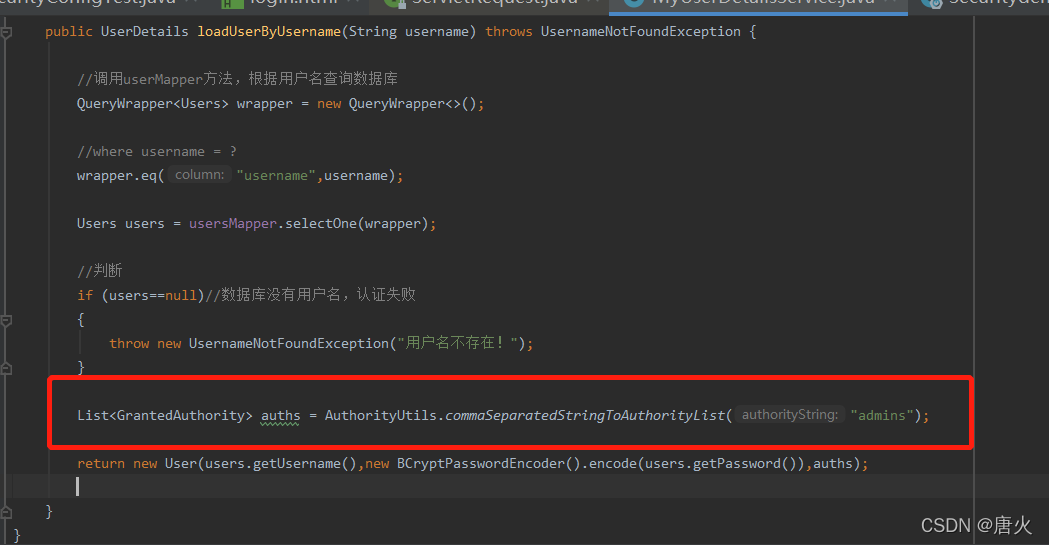基于角色或权限进行访问控制
hasAuthority 方法
如果当前的主体具有指定的权限,则返回 true,否则返回 false
在配置类设置当前访问地址有哪些

@Overrideprotected void configure(HttpSecurity http) throws Exception {http.formLogin() //自定义自己编写的登陆页面.loginPage("/login.html") //登陆页面设置.loginProcessingUrl("/user/login") //登陆访问路径.defaultSuccessUrl("/test/index").permitAll() //登陆成功之后,跳转路径.and().authorizeRequests().antMatchers("/","/test/hello","/user/login").permitAll() //设置哪些路径可以直接访问,不需要认证//当前登陆用户,只有具有admin权限才可以访问这个路径.antMatchers("/test/index").hasAuthority("admins").anyRequest().authenticated().and().csrf().disable(); //关闭csrf防护}
在UserDetailsService,把返回User对象设置权限

@Overridepublic UserDetails loadUserByUsername(String username) throws UsernameNotFoundException {//调用userMapper方法,根据用户名查询数据库QueryWrapper<Users> wrapper = new QueryWrapper<>();//where username = ?wrapper.eq("username",username);Users users = usersMapper.selectOne(wrapper);//判断if (users==null)//数据库没有用户名,认证失败{throw new UsernameNotFoundException("用户名不存在!");}List<GrantedAuthority> auths = AuthorityUtils.commaSeparatedStringToAuthorityList("admins");return new User(users.getUsername(),new BCryptPasswordEncoder().encode(users.getPassword()),auths);}
测试


没有访问权限 403



hasAnyAuthority 方法
如果当前的主体有任何提供的“角色”的话,返回true.

@Overrideprotected void configure(HttpSecurity http) throws Exception {http.formLogin() //自定义自己编写的登陆页面.loginPage("/login.html") //登陆页面设置.loginProcessingUrl("/user/login") //登陆访问路径.defaultSuccessUrl("/test/index").permitAll() //登陆成功之后,跳转路径.and().authorizeRequests().antMatchers("/","/test/hello","/user/login").permitAll() //设置哪些路径可以直接访问,不需要认证
// //当前登陆用户,只有具有admin权限才可以访问这个路径
// .antMatchers("/test/index").hasAuthority("admins").antMatchers("/test/index").hasAnyAuthority("admins”,“manager").anyRequest().authenticated().and().csrf().disable(); //关闭csrf防护}
hasRole 方法
如果用户具备给定角色就允许访问,否则出现 403。
如果当前主体具有指定的角色,则返回 true。


 从源码中我们可以看出,前面会自动加个ROLE_
从源码中我们可以看出,前面会自动加个ROLE_


hasAnyRole
表示用户具备任何一个条件都可以访问。



![[SpringSecurity]web权限方案_用户授权_自定义403页面](http://pic.xiahunao.cn/[SpringSecurity]web权限方案_用户授权_自定义403页面)

![[SpringSecurity]web权限方案_用户注销](http://pic.xiahunao.cn/[SpringSecurity]web权限方案_用户注销)

![[SpringSecurity]web权限方案_自动登陆_原理分析和具体实现](http://pic.xiahunao.cn/[SpringSecurity]web权限方案_自动登陆_原理分析和具体实现)
![[SpringSecurity]web权限方案_CSRF功能](http://pic.xiahunao.cn/[SpringSecurity]web权限方案_CSRF功能)
![[SpringSecurity]web权限方案_用户授权_注解使用](http://pic.xiahunao.cn/[SpringSecurity]web权限方案_用户授权_注解使用)



![[SpringBoot2]@MatrixVariableUrlPathHelper](http://pic.xiahunao.cn/[SpringBoot2]@MatrixVariableUrlPathHelper)

![[SpringBoot2]Thymeleaf](http://pic.xiahunao.cn/[SpringBoot2]Thymeleaf)

![[SpringBoot2]拦截器](http://pic.xiahunao.cn/[SpringBoot2]拦截器)

![[SpringBoot2]错误处理_默认规则](http://pic.xiahunao.cn/[SpringBoot2]错误处理_默认规则)

![[SpringBoot2]原生组件注入_原生注解与Spring方式注入](http://pic.xiahunao.cn/[SpringBoot2]原生组件注入_原生注解与Spring方式注入)